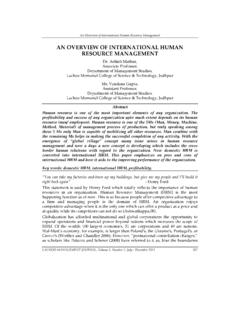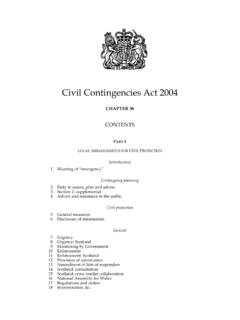Transcription of Youth unemployment in Nigeria: A time for …
1 international journal of Business and Marketing Management (2); pp. 18-26, July 2013 Youth unemployment in nigeria : A time for creative intervention Salami Department of Business Administration and Marketing, Faculty of Management Sciences, Delta State University, Asaba, nigeria . E-mail for Correspondence: Abstract: Youths represent a very important stakeholder in any society. The solutions to adult problems tomorrow depend on how children grow today. unemployment in nigeria is a time bomb waiting to explode if effective interventions are not put in place to mitigate the unsavoury impact of high Youth unemployment . This paper establishes a link between entrepreneurship and Youth unemployment if adequate attention is focused on the creation of enabling socio-economic and political environment that can galvanize a culture where the youths think of job creation away from the mindset of job seekers.
2 This paper proposes a vigorous reorientation to embrace a tested culture of honesty, creativity, hard work as well as nobility of character and for the youths to shun the easy-way-out of life. Keywords: Youth , unemployment , creativity, entrepreneurship, get-rich-quick syndrome. INTRODUCTION Records from the National Population Commission (2001) indicate that youths under the age of 30 constitute over half of the approximately 150 million Nigerians. According to Doreo Partners (2013) unemployment rate in nigeria is growing at the rate of 16% per year with the Youth impacted the most and accounting for three times the general unemployment . nigeria s spiralling Youth unemployment can be said to have significantly contributed to the dramatic rise in social unrest and crime such as Niger Delta militancy, Boko Haram and the Jos crisis. One implication of the above is that in another one to-two decades most of the youths of today will be parents in their mid-life years, and with little or no adequate skills in a fast emerging competitive global economy, it is doubtful how they can propel the needed wheel of development.
3 Woolfolk (1998) argued that the youthful years mark the critical stage of human development when they are amenable to training in entrepreneurship as opposed to self-destructive behaviours. Have Nigerian policy makers been able to see through the connection between entrepreneurship and unemployment ? Have they been able to conceive and formulate effective policies aimed at frontally addressing unemployment among the youths? It is believed that while entrepreneurship may not be the absolute panacea to Youth unemployment , an enabling environment that nurtures entrepreneurship is capable of reducing Youth unemployment by half. Purpose This paper seeks to establish the relationship between creative entrepreneurial programs and Youth unemployment . Specifically, it: Assesses the prevailing rate of unemployment among nigeria youths. Determine the geographical pattern of unemployment . Assess past government efforts at reducing Youth unemployment .
4 Propose creative strategies that can promote job creation aimed at reducing Youth unemployment . 19 Methodology Data for this paper were derived from secondary sources including previous research and analysis by scholars, government documents, newspapers/magazines as well as journal articles that are related to the subject. This study analyzed the present status, problems and prospects of entrepreneurship as part of the roadmap to wealth creation and reduction of unemployment among Nigerian youths. Why have Nigerian policy makers failed to see the connection between entrepreneurship and Youth unemployment ? Can nigeria actualize its vision of being among the top 20 economies by the 2020 as envisaged in its vision 20:2020 document? As indicated earlier, Nigerian policy makers have not given entrepreneurship its deserved attention. This paper posits that entrepreneurship is the veritable roadmap to reducing unemployment among Nigerian youths.
5 What is Entrepreneurship A definition of entrepreneurship has been debated among scholars, researchers, and even policy makers since the concept was first established in the early 1970s. Sternfioff and Burgers (1993) view entrepreneurship as the ability to develop a new venture or apply a new approach to an old business. According to Gana (2001), entrepreneurship is the ability to develop a new venture or apply a new approach to an old business. He views entrepreneurship as the ability to seek investment opportunities and persisting to exploit that opportunity. On the other hand, Anayakoha (2006) sees the entrepreneur as one who chooses or assumes risks, identifies business opportunity, gathers resources, initiates action and establishes an organization or enterprise to meet such demand or market opportunity. Allawadi (2010) made a distinction between enterprise and entrepreneur. He describes the carrying out of new combinations as enterprise and the individual whose function it is to carry them out as entrepreneur.
6 He further tied entrepreneurship to the creation of five basic new combinations of introduction of a new product, a new method of production, opening a new market, conquest of new source of supply and creating a new organization. Stevenson (2002) defines entrepreneurship as the pursuit of opportunity through innovative leverage of resources that for the most part are not controlled internally. Though the idea that entrepreneurs are innovators is largely acceptable it may be difficult to apply the same theory to less developed countries (LDCs). Allawadi (2010) argued that LDCs rarely produce brand new products; rather they imitate products and production processes that have been invented elsewhere in developed countries. He refers to this practice as creative imitation . Frequently, entrepreneurship is thought to apply only to the management of small businesses such as roadside furniture makers, cobbler, tyre vulcanizers, hairdressers and so on, but recent giants like Dell computers and Microsoft have shown how a small business that started small can grow into a conglomerate if given an enabling environment.
7 Drucker (1998) proposes that entrepreneurship is a practice. What this means is that entrepreneurship is not a state of being nor is it characterised by making plans that are not acted upon. One argument may be that entrepreneurship begins with action which involve the creation of new organization which may or may not be self-sustaining nor earn significant revenue. Regardless of the outcomes, when an individual creates a new organization, he has entered the entrepreneurship paradigm. Some individuals apply the concept of entrepreneurship to the creation of any new business, while others focus on intentions believing that entrepreneurs merely seek to create wealth. This is different from starting a business as a means of working for yourself rather than working for others. Others tend to confuse managing a small business with entrepreneurship. But Stevenson and Grousbeck (1999) argued that not all small business managers are entrepreneurs because they don t innovate.
8 On the other hand, Stoner et al (2000) note that the function that is specific to entrepreneurs is the ability to take the factors of production land, labour and capital and use them to produce new goods and services. However, they argue that entrepreneurs perceive opportunities that other business executive do not see or care about. Creativity and entrepreneurship promote the birth of new firms which is critical to economic development efforts. Therefore, a definition which seem to fully capture the true meaning of entrepreneurship is the one provided by Stevenson and Gumperts (2002) as a process in which individuals pursue opportunities fulfilling needs and wants through innovation together with the attendant risks. Based on the above definitions, it can be concluded that entrepreneurship is the process of carefully determining and analyzing unmet needs through creatively satisfying those needs by bearing the related risks.
9 By combining the above thoughts, it can be argued that entrepreneurs are risk bearers, coordinators, organizers, gap-fillers, leaders and innovators. Basic Types of Entrepreneurship There are essentially two types of entrepreneurship: 20 Opportunity-Based Entrepreneurship This type occurs when an entrepreneur perceives a business opportunity and chooses to pursue it. Ernst and Young (2009) in a survey found that majority of entrepreneurs said they saw economic slow down as the perfect time to pursue new market opportunities. In addition, economists, academics and industry leaders agree that recession tend to favour the naturally innovative temperament of entrepreneurs Necessity-Based Entrepreneurship This occurs when an entrepreneur is left with no other viable option to earn a living. It is borne, not as a choice but compulsion which makes him or her choose entrepreneurship as a career. An example is the Nigerian Civil War of 1967-1970 when the economic embargo introduced by Federal Government forced the secessionist Biafra to develop fuel oil from coconut and palm oil.
10 unemployment Defined unemployment or joblessness, as defined by the international Labour Organization (1982) occurs when people are without jobs and they have actively sought work within the past five weeks. The unemployment rate is a measure of the prevalence of unemployment and it is calculated as a percentage by dividing the number of unemployed individuals by all individuals currently in the labour force. The Newsweek (2011) reported that more than 200 million people globally are out of work, a record high, as almost two-thirds of advanced economies and half of developing countries are experiencing a slowdown in employment growth. Dependence on jobs to make money to buy food and shelter was the beginning of unemployment . Because it has not always been acknowledged or measured systematically, there are limited historical records on unemployment . Recognition of unemployment occurred slowly as economies across the world industrialized and bureaucratized.









